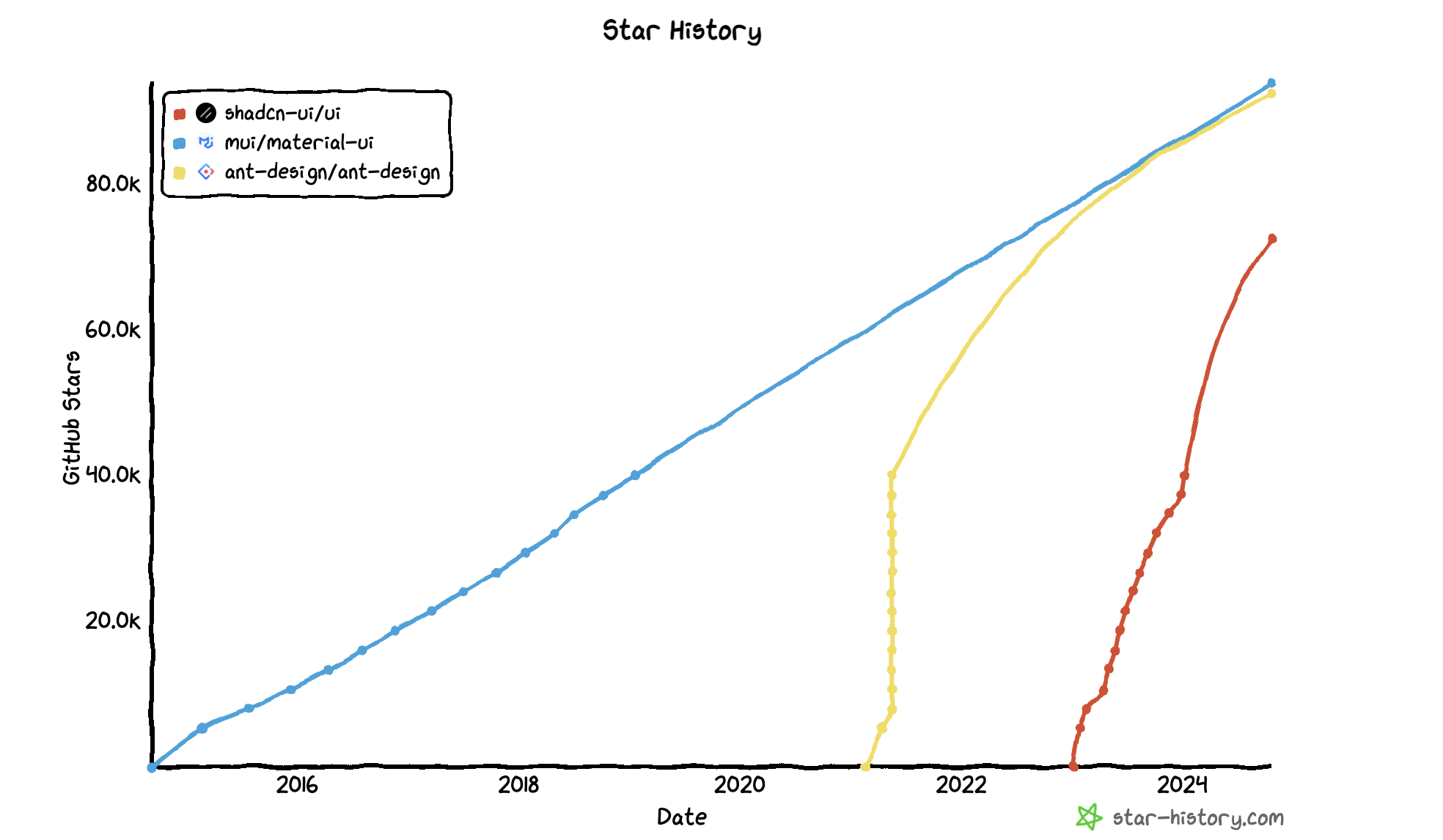How Shadcn Cut Through the Noise and Became React’s Default Component Library
When the maker of Shadcn launched the new <Sidebar /> component this week, the post went viral. It received more than 11k
likes and was seen by roughly one million people on X alone, cementing Shadcn’s role as the default component library for
new React projects.
How popular is Shadcn exactly?
It is hard to assess the popularity of libraries. A common way to do so is by looking at GitHub stars, followed by the realization that GitHub stars are a poor metric for library success. Let’s look at them anyway.

Today, Shadcn is the third most starred component library in the React ecosystem, behind Material UI and Ant Design. However, Shadcn seems to be at the height of its popularity, growing fast, while its competitors seem dated and boring.
But is it even a component library?
If you open the Shadcn docs, you’ll be greeted with the following quote:
This is NOT a component library. It's a collection of reusable components that you can copy and paste into your apps.
Shadcn is components without a library.
We can think of it as a development tool that injects components, libraries, and utilities into your code without being a dependency itself.
The components it injects are often unstyled Radix UI primitives with a thin coating of Tailwind CSS. For other components, Shadcn will inject libraries like Sonner or react-resizable-panels into your repository.
For the sake of comparison, I will treat Shadcn like a component library in this article, even though this is a sure way to get people mad.
The history of Shadcn
There are three notable milestones in the development of Shadcn.
The first is its launch in January 2023. At that time, Shadcn was nothing more than a repository containing components styled with Tailwind CSS. To use Shadcn, developers had to visit the repository, copy the component code, create a new file, and paste the code.
This leads to the second milestone: The addition of the CLI. In June 2023, the CLI was added. Since then, developers have been able to use today's familiar interface to add components to their code:
npx shadcn@latest add accordion
The third and final milestone in Shadcn’s life was Vercel’s acquisition of Shadcn in July 2023. Vercel subsequently integrated it deeply with their platform, using it for the Vercel dashboard, landing page, and most notably V0.
V0 by Vercel is a ChatGPT-like interface for building user interfaces with Shadcn and Tailwind CSS - I highly recommend giving it a try. By only using Shadcn, V0 generates consistant designs that are sure to get us all unemployed by 2025. But back to Shadcn!
How Shadcn cut through the noise
Most component libraries are iterations of the same thing. Since they are hard to customize, they follow a natural saturation curve. As soon as they are widely used, they stop being cool. Early adopters move on.
Shadcn approached the same problem as traditional component libraries from a different angle.
While building a library is the standard approach, the creator of Shadcn recognized that hiding code deep in node_modules is suboptimal.
He chose to design Shadcn as a mixture of a utility library, styled component library, and headless component library, arriving at a system
that is highly customizable while offering good defaults out of the box. He freed components from their node_module prison so we could
interact with them.
Lastly, Shadcn integrates deeply with AI capabilities, offering AI code generation abilities beyond what other component libraries offer with V0.
Does this go beyond component libraries?
The popularity of Shadcn might have importance beyond the notoriously noisy JavaScript ecosystem. Very broadly, Shadcn poses the question:
When is abstracting code into a library a bad thing?
From here, it’s easy to envision a world in which libraries like lodash stop being libraries and start to become utilities that should be placed into our codebases for customization, instead of hiding their code in dependency modules. And why stop at utility libraries?
It might be worth revisiting any library that balances customizability and utility (making something complex easily accessible).
Add Clay-like data enrichment to your application
Pipe0 is the world's most powerful data enrichment framework. Combine 50+ enrichment providers, web scraping and AI to find company and people data.